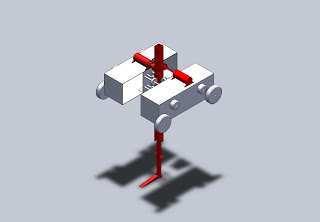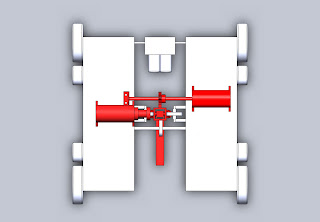Our group were able to completely manufacture the different parts of the MCM(arm of the robot), and assemble them together to demonstrate it's function. This week, we spend time in creating the spool, and the wedge of the MCM, both crucial parts in the arm's working process.
With the 1" diameter by 12" length aluminum cylinder that Dylan order last week, we began to create our spool. First we started off by lathing the spool in to the correct diameter. On Monday the 23rd we were able to create the thin cylindrical axle for the spool, but had to stop there due to lack of time. On the following day we finished off the spool by lathing off the inner part. This inner part was to be used for curling up the threads and making the wedge become horizontal as the spool rotates. When the cylinder was lathed into correct dimension, we cut the rest of the unwanted cylinder off with the Bandsaw. We finished off the spool by drawing a tiny hole through the outer circle of the spool head (not the axle). The thread was placed through this tiny hole and was tied up.
In the case of the wedge, we first had to cut the 1"x1"x12" square aluminum stock in to the dimension needed, and then we used the milling machine to shape it into a wedge shape designed as our Solidworks engineering drawings. When all the milling process was complete, we drilled the two parallel holes that will be connected to our Joining arm, which was manufactured previously. The wedge was then filed and polished by using a hand-file and sand paper. When we created the wedge, it gave us a small impression that we might have to reconsider the size of the wedge, since it was smaller than what we expected.
Further constrains for the gear and the axle of the spool were created by simply cutting and drilling the right angle aluminum. Then the ball bearings and the bushing were placed into the holes by press-fitting them.
When all our parts for the MCM was completed, we assembled them and connected them together with bolts that Andrew ordered.








